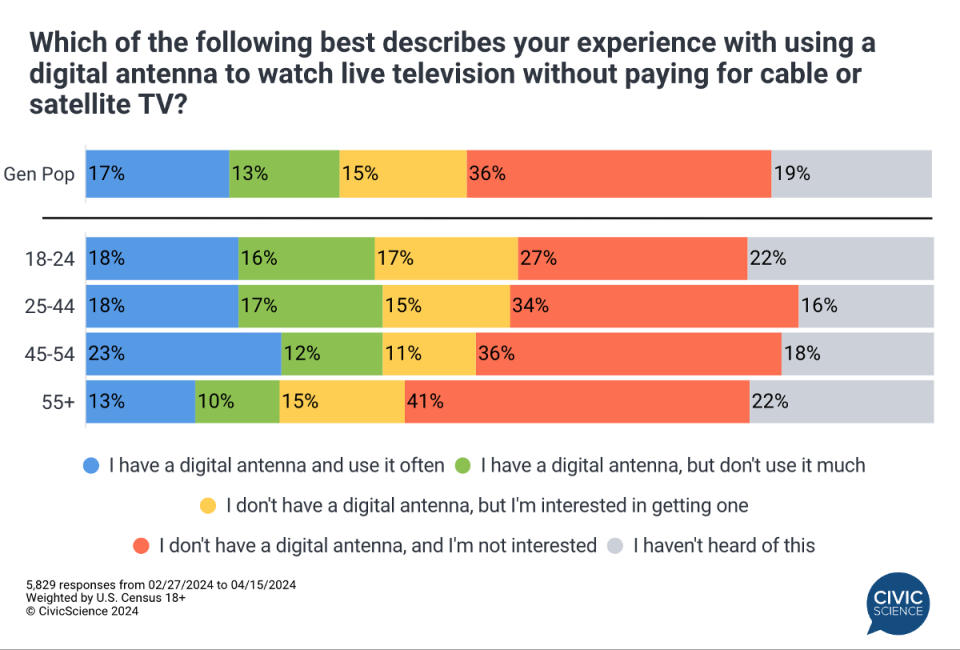Why Do So Many Millennials Have a TV Antenna?

“In-home antennas are the fastest-growing way Americans are accessing television today,” according to CivicScience. However, the group that has led the push are millennials — those between ages 25-44.
The research company found that nearly one-third (30 percent, to be exact) of U.S. adults have a digital or traditional TV antenna, which allows a household to receive signals from local broadcast stations for free. Of that general population, 17 percent use their digital antenna often — the other 13 percent, not so much. Additionally, 15 percent of the respondents to CivicScience’s survey who do not own a digital antenna are interested in getting one.
More from IndieWire
While Americans aged 45-54 — let’s call them young Gen X-ers — are the biggest over-the-air users (23 percent use an antenna), millennials (25-44) tie the 45-to-54-year-olds as the group most likely to own an antenna. Both are at 35 percent.
Gen Z is the most interested in converting (17 percent) to an antenna; adults 55+ are the least interested. Less than a quarter of the 55-and-older crowd have antennas, even though they’re the group that are the most likely to have grown up with one. Perhaps bad experiences from the past have turned them off to the idea. (Of course, theirs were on-roof monstrosities; modern-day TV antennas are predominantly digital and stay indoors.)
There are bigger reasons those 55+ avoid antennas, in this reporter’s opinion. For starters, older individuals are not particularly tech savvy and are thus more likely to get their TV service from an old-fashioned cable provider. Younger people are more likely to adopt new technologies. (CivicScience found awareness levels to be the same at both ends of the spectrum.)
Younger people also tend to have less disposable income than older (still-working) Americans, so the idea of free is pretty appealing. But the most probable reason antennas skew younger vs. older is that it is the young TV viewers who have cut the cord — or never had one in the first place — and can benefit the most by accessing broadcast television via a $20 device that requires no subscription.
Here is the generation gap depicted in graph form:

With a lack of real-time data available on antenna use and antenna users available, CivicScience recently created its Over-the-Air Audience Tracker, which it announced on Tuesday. The research company maintains a database of more than 100,000 over-the-air TV viewers with half-a-million data points. This particular study is based on 5,829 responses and is weighted against U.S. census data.
A subsection of that group surveyed found that not all over-the-air antenna (OTA) owners are cord cutters, though most — two-thirds of them — are cord nevers, or those who never had traditional cable to begin with, are counted in the one-third.
Advertisers (should) covet OTA users, who are more likely than non-antenna users to be influenced by TV advertising, CivicScience says. The OTA crowd enjoys upscale dining and travel, the survey found, and follows beauty trends. Antenna users are also optimistic about their finances; given the upscale dining and regular travel, they’d better be. (There goes our disposable income theory.)
Best of IndieWire
The Best LGBTQ Movies and TV Shows Streaming on Netflix Right Now
Guillermo del Toro's Favorite Movies: 54 Films the Director Wants You to See
Nicolas Winding Refn's Favorite Films: 37 Movies the Director Wants You to See
Sign up for Indiewire's Newsletter. For the latest news, follow us on Facebook, Twitter, and Instagram.

